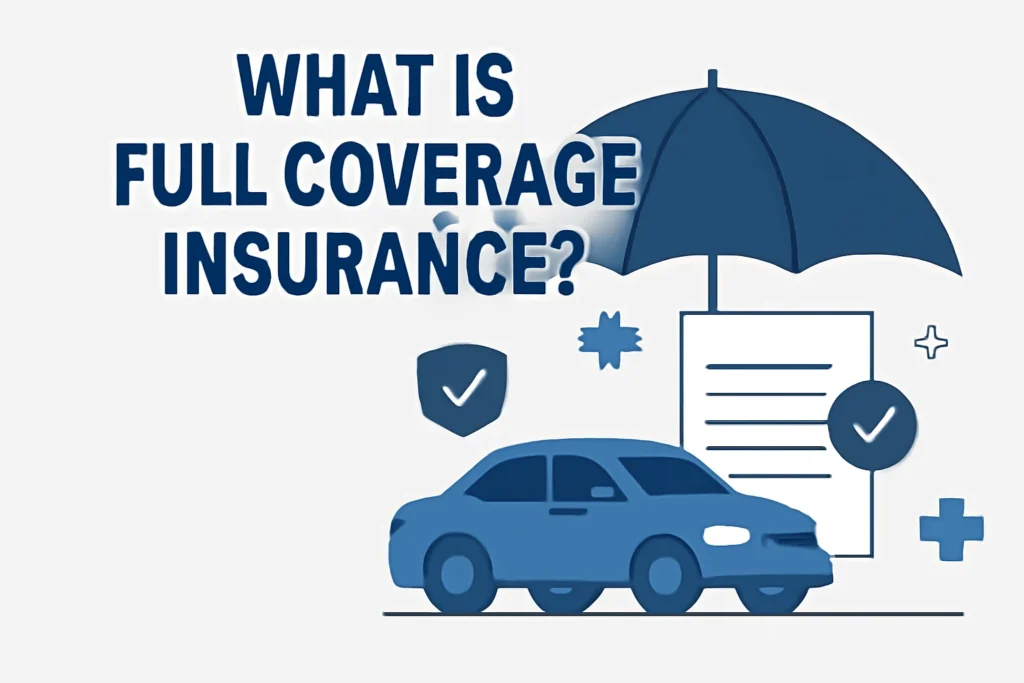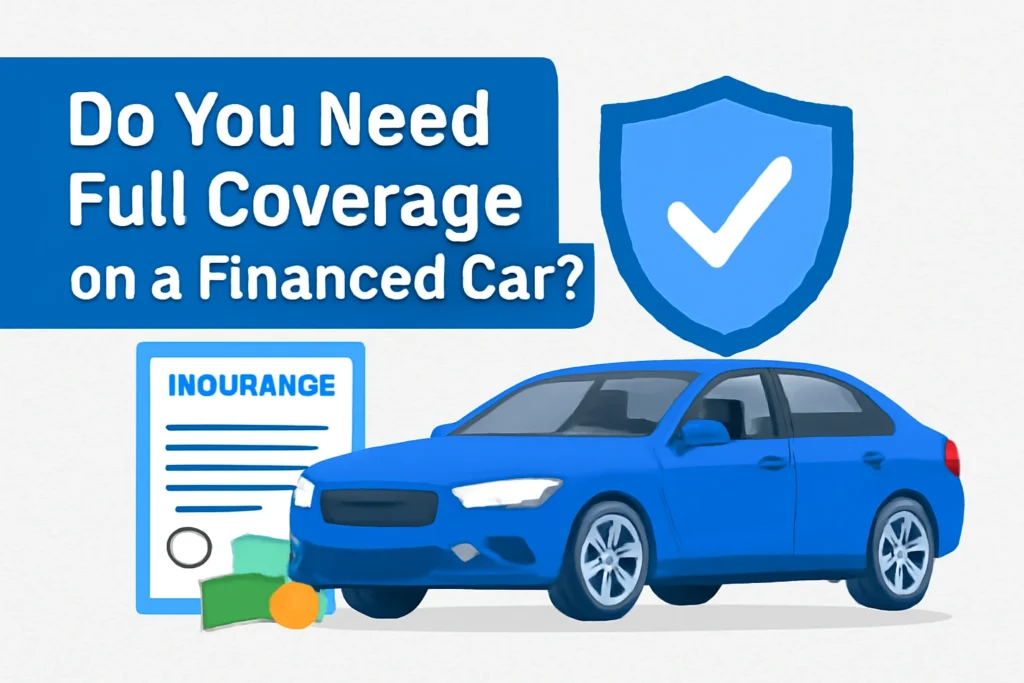Do You Need Full Coverage on a Financed Car?
When you finance a car, the lender’s main priority is protecting their investment, and that’s where full coverage insurance becomes essential. Unlike minimum liability coverage, full coverage — which typically includes collision, comprehensive, and sometimes gap insurance — ensures that damage to your vehicle is covered whether it’s new or a used financed car. Many lenders require this protection for the entire finance period to avoid financial risk if the car is damaged or totaled, emphasizing the need for full insurance coverage. By maintaining the right insurance coverage, you safeguard both your finances and your lender’s interest throughout the car loan term.
Understanding a Financed Car and Insurance Requirements
A financed car is a new or used vehicle purchased through an auto loan, where the lender holds a financial stake until the loan is fully repaid.
What is a Financed Car?
It’s a car you buy with financing instead of paying in full upfront, meaning the lender has rights over the vehicle during the finance period.
Why Lenders Require Insurance on Financed Cars
Most lenders require full coverage car insurance — including liability, collision, and comprehensive coverage — to protect their investment.
The Role of Coverage in Protecting Lender’s Investment
Proper insurance coverage ensures that if the financed vehicle is damaged or totaled, repair or replacement costs are covered, reducing financial risk for both parties.
What is Full Coverage Insurance?
Full coverage insurance is a policy package designed to protect both you and your lender’s investment, offering more than just the minimum liability insurance required by law.

Components of Full Coverage (Liability, Collision, Comprehensive)
Liability coverage pays for damages you cause to others, collision coverage repairs your own vehicle after an accident, and comprehensive coverage handles non-collision events like theft, fire, or weather damage.
Optional Add-ons Like Gap Insurance
Gap insurance is crucial for financed vehicles, covering the difference between the car’s value and the loan balance if it’s totaled.
How Full Coverage Differs from Minimum Liability Insurance
Unlike liability-only coverage, full coverage also protects your financed car itself, reducing out-of-pocket expenses after unexpected incidents and ensuring you have the necessary motorist coverage.
Do You Really Need Full Coverage on a Financed Car?
When you finance a car, lenders usually require full coverage insurance for the entire finance period to protect their investment.
Lender’s Perspective & Contract Requirements
Loan agreements typically state that liability, collision, and comprehensive coverage must be maintained until the car loan is paid off, ensuring the financed vehicle is fully protected with full coverage on a used financed car.
Risks of Dropping Full Coverage Mid-Loan
If coverage lapses, the lender may add costly force-placed insurance or take legal action, leaving you with higher expenses.
Real-World Example
A driver with a used financed car dropped full coverage, then totaled the vehicle in an accident — leaving them with loan payments but no car.
Full Coverage for a Used Financed Car
Even a used financed car must carry full coverage insurance because the lender’s investment remains at risk until the auto loan is repaid.
Is It Different from a New Car?
The coverage requirements are often similar for new or used vehicles, though premiums may differ based on the car’s value and condition.
Why Used Financed Cars Still Need Comprehensive Protection
Comprehensive and collision coverage protect against accidents, theft, and damage, ensuring the lender won’t lose money if the car is totaled, which is why you need full coverage insurance.
Cost Considerations for Older Vehicles
Insurance costs for older financed cars can be lower, but factors like mileage, safety features, and repair costs still influence the premium.
Factors That Affect Full Coverage Costs
Full coverage insurance premiums for financed vehicles can vary widely depending on several key factors.
Age & Value of the Car
Newer and higher-value cars typically cost more to insure due to expensive repair or replacement costs, while older, lower-value cars may have lower premiums.
Driver’s History & Location
A clean driving record usually leads to lower rates, while accident history, traffic violations, or living in high-risk areas can increase costs, impacting your ability to apply for financing.
Insurance Provider & Policy Terms
Different insurers offer different rates and discounts. Comparing quotes and understanding policy terms can help you secure the best coverage for your budget.
Full Coverage vs. Liability Only for Financed Cars
When financing a car, choosing between full coverage and liability-only insurance can impact both your protection and lender approval. Here’s a quick comparison:
| Feature | Full Coverage | Liability Only |
|---|---|---|
| Covers lender’s investment | ✅ Yes | ❌ No |
| Pays for your car repairs | ✅ Yes | ❌ No |
| Meets most lender requirements | ✅ Yes | ❌ No |
| Average cost per year | Higher | Lower |
| Includes comprehensive & collision | ✅ Yes | ❌ No |
Consequences of Not Maintaining Full Coverage
Failing to maintain full coverage on a financed car can lead to serious complications with your lender, who may require gap insurance.
Lender Force-Placed Insurance
If your insurance lapses, lenders may purchase force-placed insurance on your behalf, which is often much more expensive and provides limited protection.
Higher Costs & Limited Benefits
Unlike your own policy, force-placed insurance doesn’t cover damages to your vehicle, leaving you financially vulnerable.
Potential Legal or Contractual Issues
Dropping required insurance may violate your loan agreement, risking penalties, default, or even repossession of your financed vehicle, especially if your lender has to enforce known as force-placed insurance.
Considering Financial Aspects Alongside Insurance
Managing a financed car involves more than just insurance coverage. It’s important to consider additional financial factors like broker fees, loan interest rates, and other costs that can affect your overall expenses when you apply for financing. Before finalizing your car financing or insurance decisions, it’s wise to understand these extra charges. For instance, How much brokers charge for selling a business and financing a new or used vehicle can vary significantly. can give insight into common fees involved in financial transactions, helping you plan better.
Alternative Insurance Options for Financed Vehicles
Financed vehicle owners have several strategies to lower full coverage insurance costs without sacrificing protection.
Bundling Discounts
Many insurers offer discounts when you combine your auto insurance with other policies like home or renters insurance, helping reduce premiums on full coverage on a used car, which is a type of insurance.
Choosing Higher Deductibles
Opting for a higher deductible can lower your monthly premium, but it means paying more out-of-pocket in case of a claim—balancing risk and reward is key.
Shopping Around for Quotes
Comparing insurance quotes from multiple providers ensures you find competitive rates tailored to your needs, including insurance for financed vehicles.
If you’re exploring opportunities in different industries, here’s an updated insight into the insurance rate trends affecting financing and obtaining a loan. technology jobs in 2024 to broaden your horizons.
FAQs
Q1: What does full coverage include for a financed car, especially if it’s a new or used car?
Full coverage usually includes liability, collision, and comprehensive insurance, protecting both you and your lender against damages and accidents.
Q2: Can I drop full coverage before my loan ends, or will my lender purchase insurance on your behalf?
Most lenders require full coverage throughout the loan term; dropping it early can lead to penalties or force-placed insurance.
Q3: How much does full coverage cost for a used financed car?
Costs vary based on car value, location, and driver history but tend to be lower than for new cars due to depreciation.
Q4: Is gap insurance required for all financed cars?
Gap insurance isn’t mandatory but is highly recommended to cover the difference if your car is totaled and you owe more than its value.
Q5: Will my lender allow liability-only coverage, or will they require gap insurance?
Generally, no. Lenders usually require full coverage insurance for financed vehicles until the loan is fully paid.
Q6: Does full coverage include roadside assistance?
Some policies include roadside assistance, but it’s often an optional add-on.
Q7: What happens if my financed car is totaled without full coverage?
You may still owe the remaining loan balance, as liability-only coverage won’t cover your own vehicle’s damage; thus, it’s essential to have full insurance coverage.
Q8: Can I finance a used car without full coverage?
Most lenders require full coverage insurance before approving financing for used vehicles.
Conclusion
While the cost of full coverage insurance can vary depending on factors like your vehicle’s age and location, maintaining it is crucial when you finance a car. Full coverage not only protects your investment but also satisfies lender requirements, offering peace of mind throughout the loan period. Skipping or dropping this coverage can lead to costly consequences and financial risk. For more expert tips and in-depth guides on financing and insurance, visit our main site Tech Radars Stay informed about the type of insurance your lender requires.


